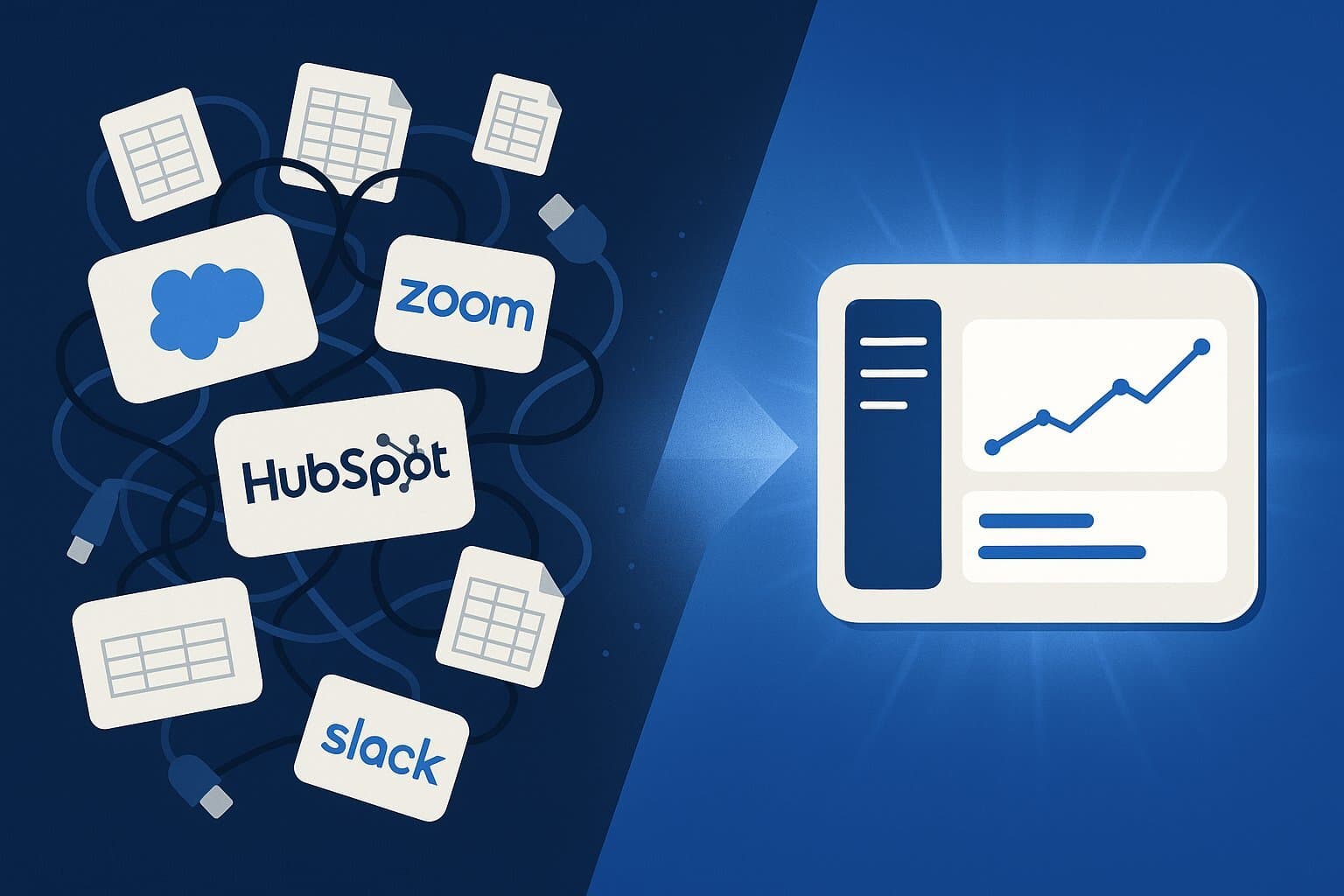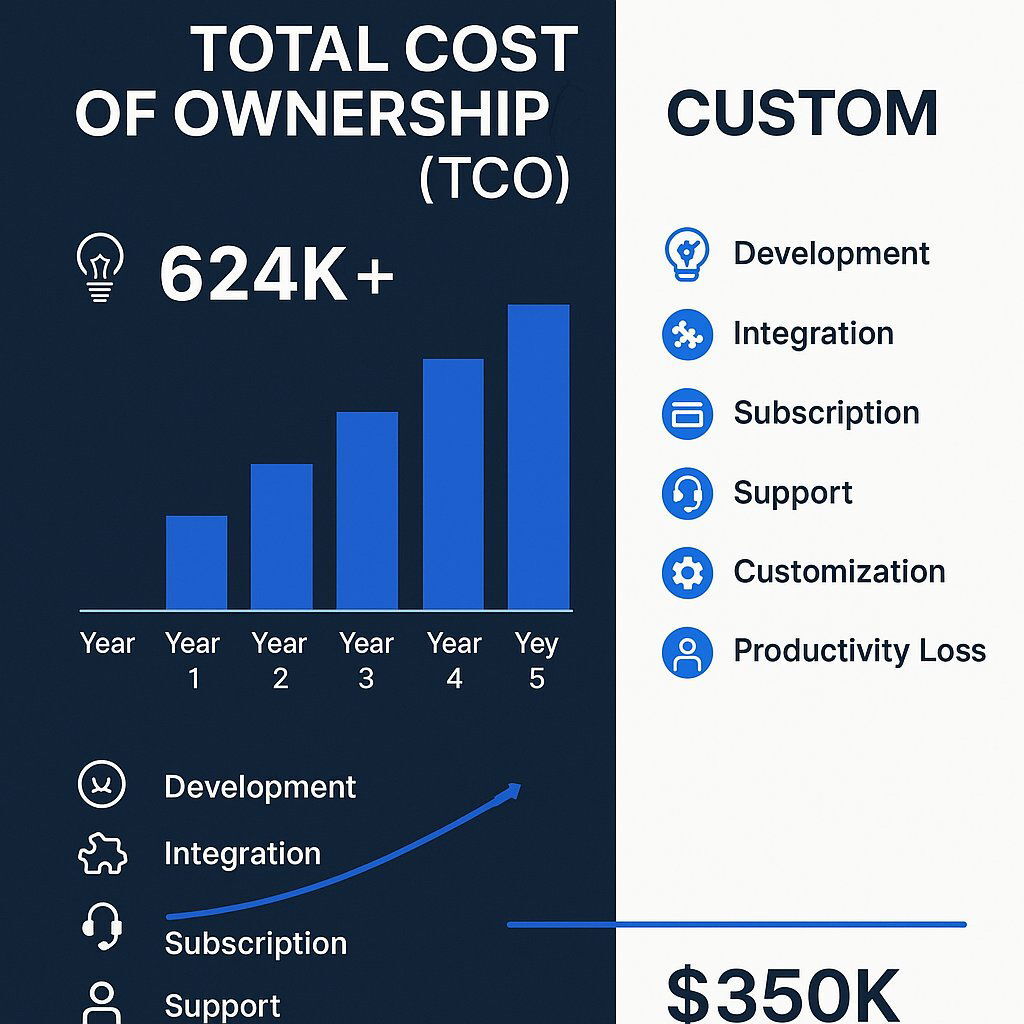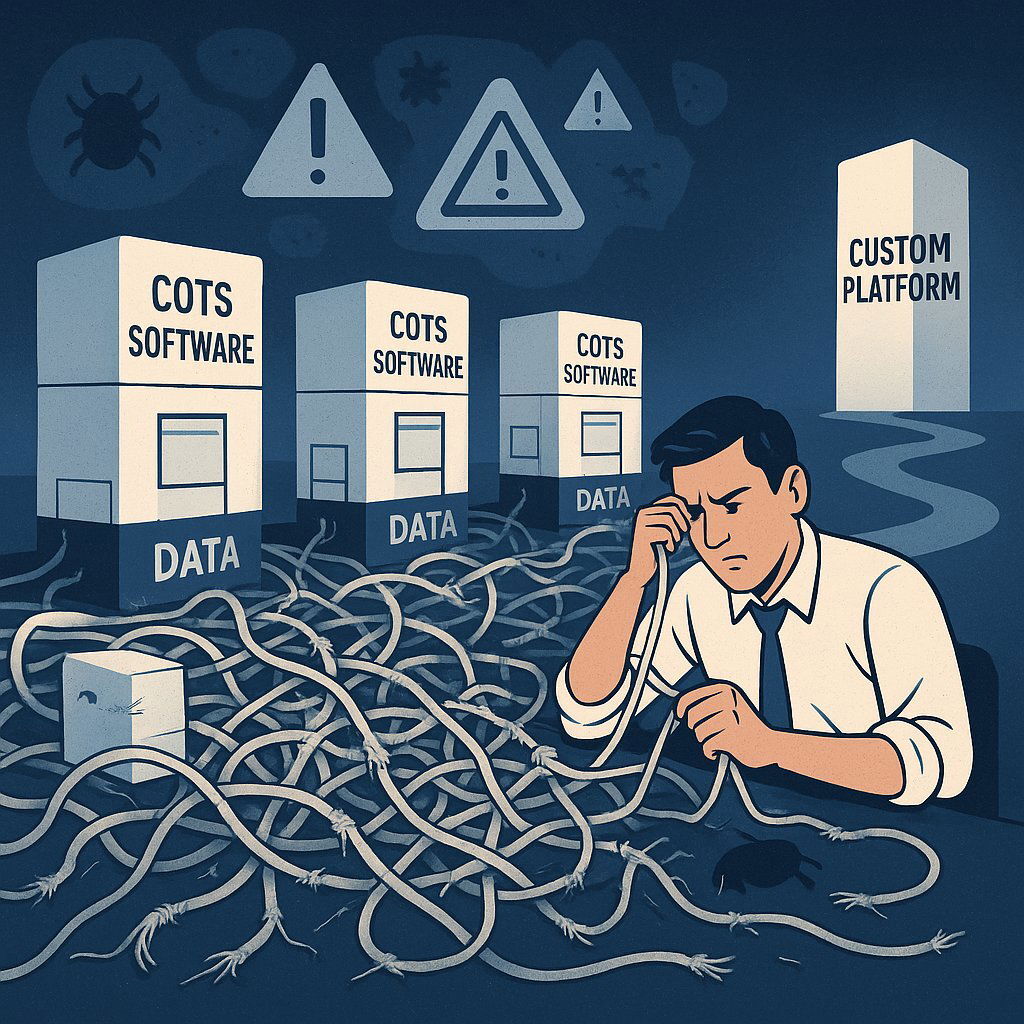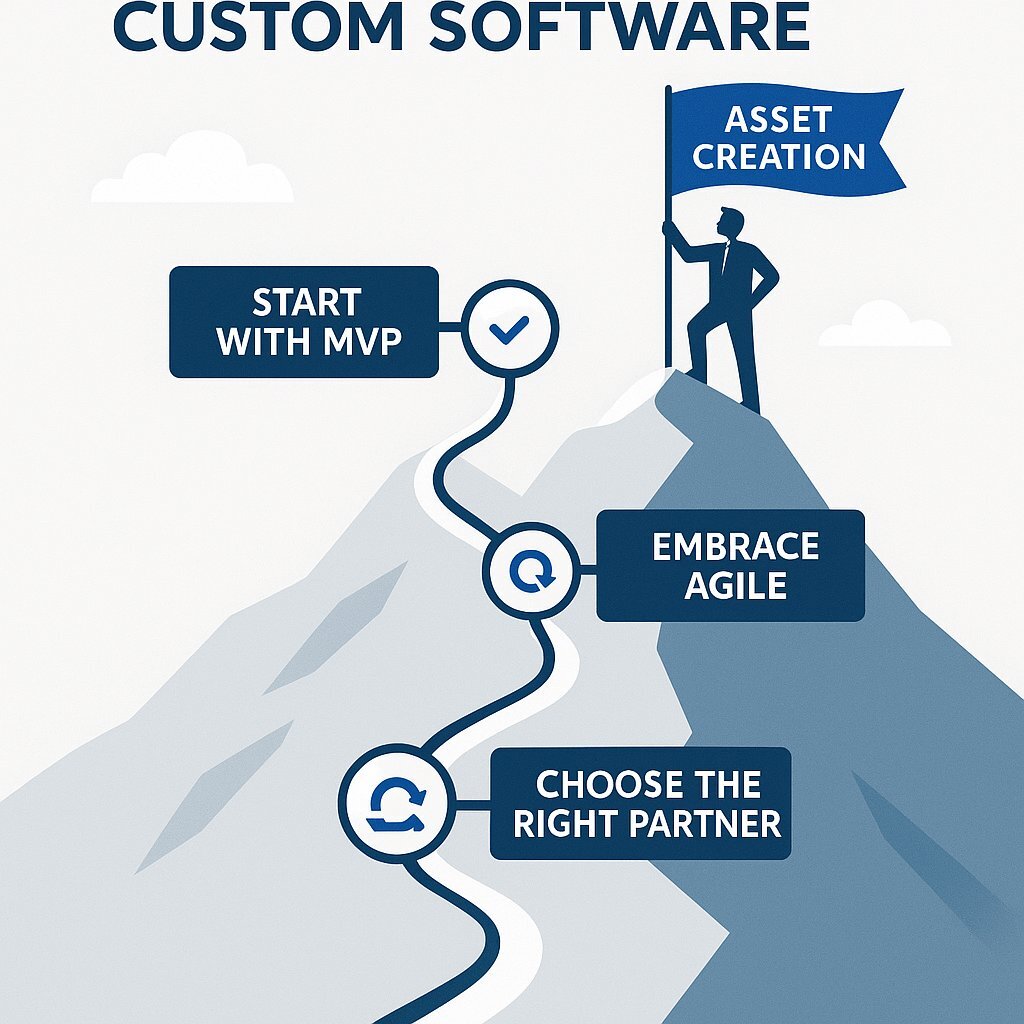
5 Signs It's Time to Build Custom Software for Your Business
October 05, 2025 / Bryan Reynolds
The Strategic Tipping Point Beyond Off-the-Shelf Software
For many growing businesses, the technology stack resembles a patchwork quilt—a collection of Commercial Off-the-Shelf (COTS) applications stitched together by a fragile web of spreadsheets, manual data entry, and third-party connectors. This "Franken-stack," once a symbol of scrappy, agile growth, eventually becomes a significant bottleneck, stifling innovation and operational velocity. The critical question leaders must eventually ask is not merely about adding another patch, but whether it is time to weave their own fabric.
The "build vs. buy" debate is not a simple procurement decision; it is a fundamental strategic choice. COTS solutions are highly effective for commoditized business functions like standard payroll or general accounting. However, a strategic inflection point is reached when forcing a company's unique, value-creating processes into a generic software box begins to erode its competitive advantage. This article serves as a diagnostic tool to help CTOs, Heads of Operations, and Line-of-Business Leaders identify this tipping point. The move toward bespoke software is not a fringe idea but a mainstream strategic shift, with a recent survey revealing that
75% of IT decision-makers believe custom software development leads to better business outcomes .
First, Let's Talk About Cost: Deconstructing the Myth of the "Cheaper" Option
The primary objection to building custom software is almost always its high upfront cost. A bespoke solution requires a significant initial capital investment compared to the seemingly low entry barrier of a COTS license fee. However, a myopic focus on this initial price tag is a critical strategic error. The only valid metric for a true comparison is the Total Cost of Ownership (TCO), which evaluates all direct and indirect costs over the software's entire lifecycle.
The true cost of "buying" software unfolds over time through a cascade of accumulating expenses. Per-user subscription fees, which seem manageable with a small team, can balloon into hundreds of thousands of dollars annually as a company scales. Vendors strategically gate essential features behind higher-priced tiers, forcing costly upgrades to access functionality needed for growth. Furthermore, COTS solutions rarely work seamlessly out of the box. The cost of integrating them with existing systems can range from $10,000 for simple APIs to over $100,000 for complex enterprise environments. Perhaps the most insidious cost is the "productivity tax"—the thousands of hours lost annually to inefficient manual workarounds that employees create to bridge the gap between their workflows and the software's rigid structure.
The following table provides a projected 5-year TCO comparison, offering a framework for leaders to conduct their own internal analysis and revealing how the initial savings of a COTS solution are often completely eroded over a strategic timeframe.
| Cost Component | Custom Software (Estimate) | COTS Software (Estimate) | Key Considerations & Hidden Risks |
|---|---|---|---|
| Year 1: Initial Investment | High ($200,000) | Low ($24,000) | Custom: One-time capital expense. COTS: Low entry barrier. |
| Implementation/Integration | Moderate (Included in Dev) | High ($30,000) | COTS integration is often a major, unbudgeted project. |
| Years 1-5: Recurring Costs | Predictable ($30,000; 15% of initial build) | Escalating Annually ($180,000 in Year 5 for 500 users) | COTS fees scale with headcount, punishing growth. |
| Maintenance & Support (Annual) | Predictable ($30,000; 15% of initial build) | Included or Separate Fee | Custom support is tailored. COTS support is generic. |
| Customization/New Features | Budgeted as needed | High Vendor Fees / Impossible | COTS customization risks creating unsupported "technical debt". |
| Years 1-5: Indirect Costs | Minimal (Designed for workflow) | High (Quantifiable) | The "hidden tax" of forcing processes into ill-fitting software. |
| 5-Year Total TCO | $350,000 | $624,000+ | The initial COTS savings are often erased by Year 3 or 4. |
Sign #1: Your Core Processes Are Your Competitive Moat
For many market-leading businesses, their competitive advantage lies not just in the product they sell, but in how they operate. This "secret sauce" could be a proprietary logistics model, a unique client onboarding workflow, or a specialized data analysis process that yields superior insights. Using a COTS solution for these core, differentiating processes forces a company to adapt its unique methods to a generic, industry-standard framework. This effectively commoditizes the very operational formula that sets the business apart, making its methods replicable by any competitor that purchases the same software license.
Custom software achieves the opposite. It takes these unique processes and codifies them into a proprietary intellectual asset. The software becomes an engine built specifically to execute the company's unique business strategy, creating a competitive moat that is incredibly difficult for others to cross. COTS vendors, by necessity, design their products to appeal to the broadest possible market, optimizing for the
average business. A company's competitive advantage, however, is rooted in its
non-average attributes. Applying a tool designed for the median to a process that is explicitly exceptional creates a fundamental strategic mismatch. Relying on COTS for core functions is, therefore, a strategic decision to regress toward the operational mean, sacrificing excellence for off-the-shelf convenience.
Sign #2: The Hidden Empire of Spreadsheets and Manual Workarounds
A clear indicator that a software stack is failing is the proliferation of manual processes. When teams are constantly emailing spreadsheets, spending hours on copy-paste tasks, and tracking critical data in disconnected files, it is a symptom of a system that no longer supports the business's needs. This "shadow IT" is not just inefficient; it is a significant and quantifiable financial drain.
Manual data entry has an accepted error rate of around 1%, but can be as high as 4% when no verification steps are in place. In contrast, automated systems can achieve accuracy rates above 99.9%. This disparity has staggering financial implications. According to one analysis, if correcting a single transaction error costs an average of $50, a business processing 10,000 transactions per month with a 4% error rate stands to lose
$240,000 annually just on remediation.
Beyond the cost of errors, there is the immense productivity sinkhole. Research shows that nearly half (45%) of data professionals spend over six hours per week on manual data cleansing and preparation tasks. For a team of ten, this translates to thousands of hours of low-value work per year that could be dedicated to strategic analysis. These manual workarounds represent a hidden factory within the organization, consuming resources and producing errors. A custom solution designed to automate these specific workflows eliminates this waste, freeing up human capital to focus on high-value activities that drive growth.
The table below provides a conservative model for calculating the annual cost of relying on manual data entry, transforming an operational nuisance into a clear P&L issue.
| Metric | Assumption/Calculation | Annual Financial Impact |
|---|---|---|
| Monthly Transactions | 10,000 | |
| Manual Error Rate | 1% (Conservative) | |
| Monthly Errors | 10,000 × 0.01 = 100 | |
| Avg. Cost to Correct One Error | 50 (Rework, shipping, customer service time) | |
| Direct Cost of Errors | 100 errors/month × $50/error × 12 months | $60,000 / year |
| Lost Productivity (Data Prep) | 5 analysts × 5 hours/week × $75/hr loaded cost × 50 weeks | $93,750 / year |
| Total Quantifiable Annual Loss | $153,750 / year |
Sign #3: You're Facing an Integration Nightmare
A sprawling ecosystem of disparate COTS applications inevitably creates data silos. Customer data resides in the CRM, financial data in the ERP, and operational data in a separate logistics platform. Achieving a unified, real-time view of the business becomes a monumental effort, often requiring manual data consolidation in spreadsheets—a process that is both slow and error-prone.
This leads to the accumulation of "integration debt." For a CTO, this is a critical concept. Quick, point-to-point integrations between COTS systems are like taking on high-interest technical debt. They solve an immediate problem but create a brittle, tangled web of dependencies that is expensive to maintain and makes future architectural changes incredibly difficult. This integration debt directly reduces business agility and inflates operational costs. When systems are not well-integrated, routine maintenance becomes more complex, and an update to one system can cause a cascade of failures in others.
These integrations are not a one-time cost. They require ongoing maintenance, and the custom code connecting a COTS product is often the first thing to break when the vendor pushes a mandatory, system-wide update. This creates a tax on innovation. Every new strategic initiative, such as launching a new customer portal, must first pay down this debt in the form of complex, time-consuming integration work before it can deliver value. The legacy COTS architecture acts as a direct financial and temporal drag on all future innovation, slowing the company down and making it less competitive. A custom-built platform, in contrast, is designed from the ground up to be the central source of truth. Integration is part of its core architecture, not a fragile afterthought, ensuring seamless data flow across the enterprise.

Sign #4: You Need to Own Your Data and Your Destiny
Purchasing COTS software is more than a simple transaction; it is an act of outsourcing a critical component of business strategy to a third-party vendor. This decision introduces significant external risks that are entirely outside of the company's control. This dependency is known as vendor lock-in, and its perils are numerous and severe.
The vendor's product roadmap is dictated by the needs of its broad market, not a single customer's specific strategic imperatives. A feature that is critical to a company's future may never get built. Once a business is deeply embedded in a vendor's ecosystem, it has very little negotiating leverage against sudden and substantial price hikes. The vendor may also be slow to innovate, leaving its customers stranded on a technologically inferior platform as the market evolves. Most critically, the vendor could be acquired, pivot its business, or cease operations entirely, placing the company's core operations in existential jeopardy.
Owning the software's Intellectual Property (IP) is the ultimate de-risking strategy. It means the business owns the roadmap, the data, the security posture, and the development timeline. It can pivot, scale, and adapt on its own terms, without seeking permission from an external entity. This control is not just an operational advantage; it is a financial one. COTS license fees are a recurring operational expense (OpEx) that provides no equity. In contrast, the cost to develop custom software is a capital expense (CapEx) that creates a proprietary asset on the company's balance sheet. This asset increases the company's valuation, makes it more attractive in M&A scenarios, and can even be licensed to create new revenue streams. The "build" decision, therefore, can be a sophisticated financial strategy to convert operational expenses into valuable corporate assets.
Sign #5: You've Uncovered a New Market Opportunity
The most forward-looking reason to build custom software is the realization that the internal tool needed to solve a unique business problem may be the very solution an entire industry is waiting for. This reframes the development cost from a necessary expense into a strategic investment in a potential new product line. History is filled with iconic examples of this "internal tool to commercial product" pipeline.
- Slack: The ubiquitous collaboration platform began as an internal communication tool for a video game company called Tiny Speck. When the game failed to gain traction, the team recognized the value of the tool they had built to support its development. That tool became the product, which was eventually acquired by Salesforce for $27.7 billion.
- Amazon Web Services (AWS): The world's dominant cloud computing platform was born from the internal infrastructure Amazon built to handle its own massive e-commerce operations. The company realized that its solution to scalable, on-demand computing infrastructure was a problem faced by countless other businesses and productized its internal capabilities, creating a new industry in the process.
- Basecamp: This pioneering project management tool was first created by the web design agency 37signals to manage its own client projects more effectively. The internal tool was so successful at bringing clarity to their workflows that they launched it as a SaaS product, which went on to redefine the category.
Leaders should therefore ask a critical question: "Is the problem we are solving with these painful, inefficient workarounds a problem shared by others in our industry?" If the answer is yes, then building a custom solution is not just about achieving internal efficiency; it is the first step toward market disruption and the creation of a powerful new revenue stream.
Making the Leap: A Strategic Framework for Building Custom Software
Despite its immense advantages, embarking on a custom software project is not without risk. A McKinsey survey found that large IT projects run over budget 45% of the time while delivering 56% less value than planned. Common pitfalls include budget overruns, scope creep, inaccurate estimates, and poor execution from an underqualified development team. However, these risks are not inevitable; they can be systematically mitigated with a strategic framework.

- Start with a Minimum Viable Product (MVP): The most effective way to de-risk a large project is to start small. Avoid the temptation to build a monolithic, all-encompassing solution from the outset. Instead, focus on developing an MVP that solves the single most critical business problem. This approach keeps initial costs low, allows the team to gather user feedback early, and ensures that value is delivered to the business as quickly as possible.
- Embrace Agile Methodologies: An agile development process, characterized by iterative cycles and continuous feedback, is essential. It ensures that the project remains aligned with evolving business needs and prevents the team from spending months building a solution that is no longer relevant by the time it is deployed.
- Choose the Right Partner: The single most critical factor in the success of a custom software initiative is the choice of the development partner. This is not a vendor to whom code is outsourced; it is a strategic partner that must possess a deep understanding of the business goals driving the project.
This is why the choice of a development partner is paramount. A business needs a firm that operates as a strategic advisor, not just a team of coders. Partners like Baytech Consulting mitigate these risks by starting with the business case first. They collaborate with stakeholders to conduct a rigorous ROI and TCO analysis, ensuring the project is grounded in financial reality. Their focus on an agile, MVP-first approach ensures that value is delivered early and that the final software isn't just a technical achievement, but a powerful, value-generating asset that drives measurable business outcomes.
Conclusion: Your Software Should Be an Asset, Not a Constraint
The decision to move from off-the-shelf software to a custom-built solution marks a transition from tactical problem-solving to strategic asset creation. The tipping point becomes clear when leaders diagnose the symptoms within their organization. The key diagnostic questions are:
- Are our core operational processes a key part of our competitive advantage?
- Are our teams drowning in a sea of spreadsheets and error-prone manual work?
- Has our tech stack become a brittle, expensive, and complex web of integrations?
- Do we need to own our technology roadmap and data to control our future and de-risk the business?
- Have we identified an internal problem that, if solved elegantly, could become a new commercial product?
Off-the-shelf software forces a business to adapt its strategy to the software's limitations. Custom software is a strategic asset that adapts and scales with the business, enabling its strategy rather than constraining it. If two or more of these signs resonate with current challenges, it is time to move beyond a simple cost comparison. The next logical step is to quantify the opportunity cost of inaction and project the potential ROI of a custom solution.
Ready to build the business case? Contact the experts at Baytech Consulting for a complimentary strategic assessment.
Supporting Resources
- https://online.hbs.edu/blog/post/how-to-calculate-roi-for-a-project
- https://www.outsystems.com/application-development/vendor-lock-in-challenges-and-concerns/
About Baytech
At Baytech Consulting, we specialize in guiding businesses through this process, helping you build scalable, efficient, and high-performing software that evolves with your needs. Our MVP first approach helps our clients minimize upfront costs and maximize ROI. Ready to take the next step in your software development journey? Contact us today to learn how we can help you achieve your goals with a phased development approach.
About the Author

Bryan Reynolds is an accomplished technology executive with more than 25 years of experience leading innovation in the software industry. As the CEO and founder of Baytech Consulting, he has built a reputation for delivering custom software solutions that help businesses streamline operations, enhance customer experiences, and drive growth.
Bryan’s expertise spans custom software development, cloud infrastructure, artificial intelligence, and strategic business consulting, making him a trusted advisor and thought leader across a wide range of industries.


